Nostradamus
 From Nwe
From Nwe 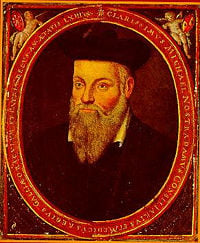
Michel de Nostredame (latinzed as Nostradamus) (December 14, 1503 – July 2, 1566) is the famed French prognosticator who is best known for his book Les Propheties, the first edition of which appeared in 1555.
Since the publication of this text, which has rarely been out of print since his death, Nostradamus has attracted a considerable following—especially among occultists and conspiracy theorists. His many enthusiasts, to say nothing of the popular press, credit him with the accurate prediction of numerous historical events. In contrast, most skeptical or academic sources maintain that the associations made between world events and Nostradamus' quatrains are largely the result of misinterpretations or mistranslations (sometimes deliberate), or else are so tenuous as to render them useless as evidence of any genuine predictive power. One of their most potent arguments is that there is no evidence that anyone has ever interpreted any of Nostradamus' quatrains specifically enough to allow a clear identification of any event in advance.[1]
Nevertheless, interest in the work of this prominent "prophet" of the French Renaissance is still considerable, especially in the media, in popular culture, and among adherents of various New Age and parapsychological movements.
Biography
Childhood
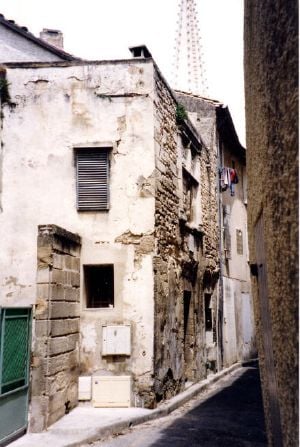
Born in Saint-Rémy-de-Provence in the south of France on December 14, 1503, Michel de Nostredame was one of at least eight children of local grain dealer and notary Jaume de Nostredame and Reynière de St-Rémy. His father's family had originally been Jewish, but Jaume's father, Guy Gassonet, converted to Roman Catholicism around 1455, taking the Christian name "Pierre" and the surname "Nostredame" (apparently a reference to the feast day on which his conversion was solemnized).[2]
Little else is known about de Nostredame's childhood, although there is a persistent tradition that he was educated by his maternal great-grandfather Jean de St. Rémy[3]—a claim that is vitiated by the fact that Jean disappears from the historical record after 1504, when the child was only one year old.[4]
Young Adulthood
At the age of fifteen, Nostradamus entered the University of Avignon to study for his baccalaureate. After little more than a year (when he would have studied the regular Trivium of grammar, rhetoric, and logic, rather than the later Quadrivium of geometry, arithmetic, music, and astronomy/astrology), he was forced to leave Avignon when the university closed its doors in the face of an outbreak of the plague. In 1529, after some years as an apothecary, he entered the University of Montpellier to study for a doctorate in medicine. He was expelled shortly afterwards when it was discovered that he had been an apothecary, a manual trade expressly banned by the university statutes. This expulsion document (BIU Montpellier, Register S 2 folio 87) can still be found in the faculty library. After his expulsion, Nostradamus continued working, presumably as an apothecary, and became famous for creating a "rose pill" that supposedly protected against the plague.[5] As an aside, it is notable that, despite his lack of academic success, some of his publishers and correspondents would later call him "Doctor."
Marriage, Tragedy and Healing Work
In 1531, Nostradamus was invited by Jules-César Scaliger, a leading Renaissance scholar, to visit him at his home in Agen. There he married a woman of uncertain name (possibly Henriette d'Encausse), who bore him two children. In 1534, despite his alchemical ministrations, his wife and children died, presumably from the plague. After their deaths, he continued to travel, passing through France and possibly into Italy.
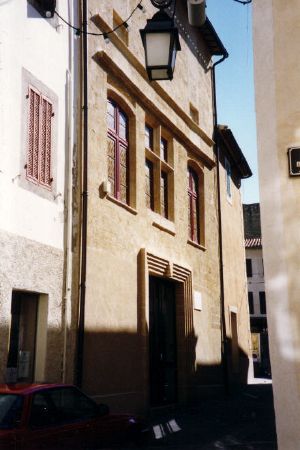
On his return in 1545, he assisted the prominent physician Louis Serre in his fight against a major plague outbreak in Marseille, and then tackled further outbreaks of disease on his own throughout the region surrounding Aix-en-Provence. Finally, in 1547, he settled in Salon-de-Provence (in a house that still stands today), where he married a rich widow named Anne Ponsarde, who bore him six more children—three daughters and three sons. Between 1556 and 1567, Nostradamus and his wife acquired a one-thirteenth share in a huge canal project organized by Adam de Craponne to irrigate largely waterless Salon and the Désert de la Crau.
Seer
After another visit to Italy, Nostradamus began to move away from medicine and towards the occult. Following popular trends, he wrote an almanac for 1550, for the first time Latinizing his name from Nostredame to Nostradamus. He was so encouraged by the almanac's success that he decided to write one or more annually. Taken together, these texts contained at least 6,338 prophecies,[6] as well as at least eleven annual calendars. The success of his almanacs soon brought a measure of fame and success to Nostradamus, such that nobility and other prominent persons soon began asking him for horoscopes and other advice.
This new level of celebrity and financial freedom allowed Nostradamus to begin his magnum opus: a book of one thousand prophetic [7] quatrains. It is this collection of largely undated prophecies that he is most famous (or notorious) for today. However, fearing that this occultic dabbling could earn him the ire of religious fanatics, he devised a method of obscuring the meaning of his text using "Virgilianized" syntax, word games and a mixture of languages, including Ancient Greek, Italian, Latin, and Provençal.
The quatrains, published in a book titled Les Propheties (The Prophecies), received a mixed reaction when they were published. While some people thought Nostradamus was a servant of evil, a fake, or insane, many others (often from the upper echelons of society) thought his quatrains were spiritually inspired prophecies—as, in the light of their post-biblical sources, Nostradamus himself was indeed prone to claim. Catherine de Médicis, the queen consort of King Henri II of France, was one of his greatest admirers. After reading Nostradamus's 1555 almanac, which hinted at unnamed threats to the royal family, she summoned him to Paris to explain their meanings and to draw up horoscopes for her children. At the time, he had feared that he would be beheaded, but by the time of his death in 1566, Catherine had made him Counselor and Physician-in-Ordinary to the King.
Some biographical accounts of Nostradamus' life state that he was afraid of being persecuted for heresy by the Inquisition, but neither prophecy nor astrology fell under this bracket, and he would have been in danger only if he had practiced magic to support them. In fact, his relationship with the Church as a prophet and healer was excellent. His brief imprisonment at Marignane in late 1561 came about purely because he had published his 1562 almanac without the prior permission of a bishop, thus contradicting a recent royal decree.
Final Years and Death
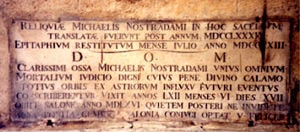
By 1566, Nostradamus' gout, which had plagued him painfully for many years and made movement very difficult, turned into edema (colloquially known as "dropsy"). In late June, he summoned his lawyer to draw up an extensive will bequeathing his property plus 3,444 crowns (around $300,000 US today)—minus a few debts—to his wife pending her remarriage, in trust for their sons pending their twenty-fifth birthdays and their daughters pending their marriages. On the evening of July 1, he is alleged to have told his secretary Jean de Chavigny, that "you will not find me alive at sunrise." The next morning he was reportedly found dead, lying on the floor next to his bed. He was buried in the local Franciscan chapel, but re-interred in the Collégiale St-Laurent during the French Revolution, where his tomb remains to this day.
Works

In The Prophecies, Nostradamus compiled his collection of major, long-term predictions. The first installment was published in 1555. The second, with 289 further prophetic verses, was printed in 1557. The third edition, with three hundred new quatrains, was reportedly printed in 1558, but today only survives as part of the omnibus edition that was published after his death in 1568. This version contains one unrhymed and 941 rhymed quatrains, grouped into nine sets of 100 and one of 42, called "Centuries."
Given printing practices at the time (which included type-setting from dictation), no two editions turned out to be identical. Certainly there is no warrant for assuming—as would-be "code-breakers" are prone to do—that either the spellings or the punctuation of any edition are Nostradamus' originals.
Since his death, only the Prophecies have continued to be widely popular. Over 200 editions of them have appeared with over 2000 commentaries. Their popularity seems to be partly due to the fact that their vagueness and lack of explicit dating make it easy to quote them selectively after any major dramatic event, thus retrospectively claiming this as evidence of their author's clairvoyance.
His Almanacs were by far the most popular of Nostradamus's works and were published annually from 1550 until his death. He often published two or three in a year, entitled either Almanachs (detailed predictions), Prognostications, or Presages (more generalized predictions).
In addition to his reputation as a diviner, Nostradamus also considered himself to be a professional healer as well. To this end, it is known that he wrote at least two medical books on the art and science of medicine. One was an alleged "translation" of Galen, though its faithfulness to the original is debatable. The second is his so-called Traité des fardemens, which was basically a medical cookbook containing mostly materials borrowed from others sources. In it, he included a description of the methods he used to treat the plague—none of which (not even the bloodletting) worked. Intriguingly enough, this same book also describes the preparation of cosmetics.
The Orus Apollo is a purported translation of an ancient Greek work on Egyptian hieroglyphs, which was based on later Latin versions of the same text. Unfortunately, all of these texts (including Nostradamus's translation) are ignorant of the true meanings of the ancient Egyptian script, which was not correctly deciphered until the discovery of the Rosetta Stone in the nineteenth century.
Literary sources
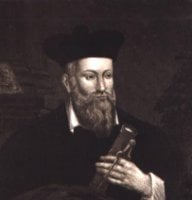
Nostradamus claimed to base his predictions on judicial astrology—the astrological assessment of the "quality" of expected future developments—but was heavily criticized by professional astrologers of the day (such as Laurens Videl) for incompetence and for assuming that "comparative horoscopy" (the comparison of future planetary configurations with those of past events) could predict actual future events.
Recent research suggests that much of his prophetic work paraphrases collections of ancient eschatological prophecies (mainly post-Biblical), which he then supplemented with references to historical events and anthologies of omen reports. These sources were then projected into the future with the aid of comparative horoscopy. Hence, many of the predictions involve ancient figures such as Sulla, Marius, Nero, and others, as well as various biblical or mythical tropes, including "battles in the clouds" and "frogs falling from the sky." Astrology itself, as a method, is mentioned only twice in Nostradamus' "Preface" and 41 times in the "Centuries," though it is discussed more frequently in his dedicatory Letter to King Henri II.
His historical sources include easily identifiable passages from Livy, Suetonius, Plutarch, and other classical historians, as well as medieval chroniclers, such as Villehardouin and Froissart. Many of his astrological references are taken almost word for word from Richard Roussat's Livre de l'estat et mutations des temps of 1549–50. The birth charts that he prepared for wealthy patrons were based on planetary tables already published by professional astrologers, though they were somewhat "personalized" through his copious copying errors. For an excellent introduction to this textual issue, see Gruber's comprehensive critique of Nostradamus’ horoscope for Crown Prince Rudolph Maximilian.[8]
His major prophetic resource was evidently the Mirabilis liber of 1522, which contained a range of prophecies by Pseudo-Methodius, the Tiburtine Sibyl, Joachim of Fiore, Savonarola, and others. His Preface, for example, contains 24 biblical quotations, all but two of which are in the order used by Savonarola.[9] The Mirabilis had enjoyed considerable success in the 1520s, when it went through half a dozen editions but did not sustain its influence, perhaps owing to its mostly Latin text, Gothic script, and use of many difficult abbreviations. Nostradamus was one of the first to re-paraphrase these prophecies in French, which may explain why they are often credited to him.
Further material was gleaned from the De honesta disciplina of 1504 by Petrus Crinitus, which included extracts from Michael Psellus's De Daemonibus, and the De Mysteriis Aegyptiorum ("Concerning the Mysteries of Egypt"), a book on Chaldean and Assyrian magic by Iamblichus, a fourth century Neo-Platonist. Latin versions of both texts had recently been published in Lyon, and extracts from both are paraphrased (in the second case almost literally) in his first two verses.
Only in the seventeenth century did people start to notice his reliance on earlier sources. Anonymous letters to the Mercure de France in August and November 1724 drew specific public attention to the fact. This may help explain the fact that during the same period, The Prophecies reportedly came into use in France as a classroom reader.[10]
Nostradamus' reliance on historical precedent is reflected in the fact that he explicitly rejected the label "prophet" (i.e. a person having prophetic powers of his own) on several occasions:
Although, my son, I have used the word "prophet," I would not attribute to myself a title of such lofty sublimity—Preface to César, 1555.[11]
[S]ome of [the prophets] predicted great and marvelous things to come: [though] for me, I in no way attribute to myself such a title here.—Letter to King Henri II, 1558.
I do but make bold to predict (not that I guarantee the slightest thing at all), thanks to my researches and the consideration of what judicial Astrology promises me and sometimes gives me to know, principally in the form of warnings, so that folk may know that with which the celestial stars do threaten them. Not that I am foolish enough to pretend to be a prophet. — Open letter to Privy Councillor (later Chancellor) Birague, 15 June 1566

Thus, any criticism aimed at Nostradamus for claiming to be a prophet simply ignores the fact that he never claimed to be one in the first place.
Given his reliance on literary sources, it is doubtful whether Nostradamus used any particular method for achieving revelations (i.e. a trance state), other than perhaps using contemplation, meditation and incubation (i.e., ritually "sleeping on it"). His sole description of this process is contained in letter 41[12] of his collected Latin correspondence. The popular legend that he attempted the ancient methods of flame gazing, water gazing, or both simultaneously is based on a naive reading of his first two verses, which merely liken his efforts to those of the Delphic and Branchidic oracles. In his dedication to King Henri II, Nostradamus describes "emptying my soul, mind and heart of all care, worry and unease through mental calm and tranquility," but his frequent references to the "bronze tripod" of the Delphic rite are usually preceded by the words "as though," indicating their metaphorical usage.
Interpretations
Classical
Most of the quatrains in the Prophecies of Nostradamus deal with disasters, such as plagues, earthquakes, wars, floods, invasions, murders, droughts, and battles—all undated and based on passages from the Mirabilis Liber. A major underlying theme in the text is that Europe is soon to be decimated by an invasion of Muslim forces led by the expected Antichrist. These prophecies are directly motivated by the then-current fear of Ottoman invasions (and the earlier Saracen equivalents mentioned in Nostradamus's source material, particularly the Mirabilis Liber). All of this is presented in the context of the supposedly imminent end times, a popular conviction that informed the publication of many contemporary eschatological prophecies.
Some scholars believe that Nostradamus did not compose his text as prophecy, but instead as a means of apocryphally commenting upon events in his own time. In this interpretation, his elusive writing style, which used highly metaphorical and cryptic language, could be seen as a means of avoiding persecution. If true, this presents similarities to the Preterist interpretation of the Book of Revelation and the Chinese bao bian ("praise and blame") style of historiography, which uses past events as analogues of present ones.
Modern
Nostradamus enthusiasts have credited him with predicting numerous events in world history, from the Great Fire of London and the rise of Napoleon, to the reign of Adolf Hitler and the September 11 attacks on the World Trade Center. Critics suggest, however, that his reputation as a prophet is largely manufactured by modern-day supporters, who modify his words such that they correspond to events that have either already occurred or are so imminent as to be inevitable (a process known as "retroactive clairvoyance"). Academic investigation has produced no evidence to suggest that any Nostradamus quatrain has ever been interpreted as predicting a specific event before it occurred, other than in vague, general terms that could equally apply to any number of other events.
At present, a tremendous range of divergent opinions about Nostradamus can be seen in printed literature and on the internet. At one end of the spectrum, there are highly critical academic views, such as those of Jacques Halbronn, which suggest at great length and with great complexity that Nostradamus' Propheties are antedated forgeries written by later hands with political axes to grind. Although Halbronn likely knows more about the texts and associated archives than almost anybody else alive (as he helped to recover and research many of them), many other specialists in the field dismiss this particular theory (though they do not argue with his general contention that the books themselves are devoid of prophetic power).
At the other end of the spectrum are the spate of recent popular books and websites arguing that Nostradamus was a true prophet. There is a consensus among these authors that he predicted the French Revolution, Napoleon Bonaparte, and the rise of Hitler. One of the first English-language books making such claims (and becoming a popular hit in the process) was Henry C. Roberts's The Complete Prophecies of Nostradamus (1947), reprinted at least seven times during the next 40 years, which contained both transcriptions and translations with brief commentaries. This was followed in 1961 by Edgar Leoni's dispassionate Nostradamus and His Prophecies, which is universally regarded as by far the best and most comprehensive treatment and analysis of Nostradamus in English prior to 1990. Another important addition to the literature was Erika Cheetham's well-known The Prophecies of Nostradamus, which incorporated a translation of the posthumous 1568 edition of the Propheties. A later edition of her text served as the basis for the Orson Welles film, The Man Who Saw Tomorrow. These popular works have reached a culmination of sorts in the writings of John Hogue, who has published several well known books on the seer from 1994 onwards, including Nostradamus: The Complete Prophecies (1999) and Nostradamus: A Life and Myth (2003). Intriguingly, many of these texts go beyond the prophecies of Nostradamus and suggest that many aspects of his biography were, in fact, supernatural.
Some common claims include the suggestion that he had been a descendant of the Israelite tribe of Issachar; that he had been educated by his grandfathers, who had both been physicians to the court of Good King René of Provence; that he had attended Montpellier University in 1525 to gain his first degree; that he had successfully taken his medical doctorate; that he had supported the heliocentric view of the universe; that he had performed a variety of prodigies, including identifying a future Pope; that he had successfully cured the Plague at Aix-en-Provence and elsewhere; that he had engaged in "scrying" using either a magic mirror or a bowl of water; that, with the publication of his Propheties, he had been summoned by Queen Catherine de Médicis to Paris in 1555 to discuss with her his prophecy at quatrain I.35 that her husband King Henri II would be killed in a duel; that he had examined the royal children at Blois; and that, when his corpse was uncovered during the French Revolution, he was found to be wearing a medallion bearing the exact date of his disinterment. As is probably obvious, none of these claims can be verified or confirmed.
However, such non-critical works spurred a counter-reaction, which began in the 1980s. Using numerous primary and secondary sources that had recently become available (including Nostradamus's private correspondence (1983),[13] original editions of the 1555 and 1557 prophetic texts, and much original archival material, many modern scholars have demonstrated that the precognitive discoveries attributed to Nostradamus simply do not fit the documented facts. These academics point out that "not one" of the claims listed above was backed up by any documentary evidence. In fact, the vast majority are based on pure invention, on modern misunderstandings of the sixteenth century French texts, and on rumors stated as fact by later commentators (such as Jaubert (1656), Guynaud (1693) and Bareste (1840)). For one example, the suggestion that quatrain I.35 had successfully prophesied King Henri II's death did not actually appear in print for the first time until 1614, 55 years after the event.
Furthermore, these academics assemble a litany of faults against many of these popular editions: the English translations are usually of poor quality, they seem to display little or no knowledge of sixteenth-century France, the historical claims are tendentious or, at worst, were sometimes twisted to fit the events to which they were supposed to refer (or vice versa).[14] The scholars were particularly scathing about later attempts by some lesser-known authors (Hewitt, 1994; Ovason, 1997; Ramotti, 1998) to extract "hidden" meanings from the texts with the aid of anagrams, numerical codes, graphs and other devices.
Notes
- ↑ Lemesurier, Peter. The Unknown Nostradamus. 2003.
- ↑ Dr Edgar Leroy. Nostradamus, Ses Origines, sa Vie, son Oeuvre. 1972. ISBN 2-86276-231-8
- ↑ J.A. de Chavigny, "La première face du Janus françois" (Lyon, 1594).
- ↑ Pierre, Brind'Amour. Nostradamus astrophile. 1993.
- ↑ Nostradamus, Michel. Traite des fardemens et des confitures. 1555, 1556, 1557.
- ↑ Chevignard, Bernard, Présages de Nostradamus 1999
- ↑ Nostradamus Homepage Centuries. Retrieved May 17, 2007.
- ↑ Gruber, Dr. Elmar, Nostradamus: sein Leben, sein Werk und die wahre Bedeutung seiner Prophezeiungen. 2003.
- ↑ Nostradamus Homepage Savonarola and Nostradamus Text Comparison. Retrieved May 17, 2007.
- ↑ de Garencières, Theophilus. The true prophecies or prognostications of Michel Nostradamus. 1672.
- ↑ Nostradamus Repository Preface to César. Retrieved May 17, 2007.
- ↑ Nostradamus Letter Index Facsimile of Letter. Retrieved May 17, 2007.
- ↑ Dupèbe, Jean, Nostradamus: Lettres inédites, 1983
- ↑ Wilson, Ian. Nostradamus: The Evidence. 2002.
Sources
- Benazra, Robert. Répertoire chronologique nostradamique. Tredaniel, 1990 ISBN 2-85707-418-2
- Brind'Amour, Pierre. Nostradamus astrophile. Ottawa: Presses de l'Université, & Paris, Klincksieck, 1993.
- Brind'Amour, Pierre. Nostradamus. Les premières Centuries ou Prophéties. Genève: Droz, 1996.
- Chevignard, Bernard. Présages de Nostradamus. Paris: Le Seuil, 1999.
- Chomarat, Michel and Laroche, Jean-Paul. Bibliographie Nostradamus. Baden-Baden: V. Koerner, 1989.
- Clébert, Jean-Paul. Prophéties de Nostradamus. Paris: Dervy, 2003.
- Dupèbe, Jean ed. Micheal Nostradamus: Lettres inédites. Geneva: Librairie Droz., 1983.
- Gruber, Dr Elmar. Nostradamus: sein Leben, sein Werk und die wahre Bedeutung seiner Prophezeiungen. Scherz: Auflage, 2003. ISBN 3502152802
- Lemesurier, Peter. Nostradamus: The Illustrated Prophecies. O Books: 2003. ISBN 1903816483
- Lemesurier, Peter. The Nostradamus Encyclopedia. Griffin: 1997. ISBN 0312199945
- Lemesurier, Peter. The Unknown Nostradamus. O Books: 2003. ISBN 1-903816-32-7
- Leroy, Edgar. Nostradamus, ses origines, sa vie, son oeuvre. Bergerac: Imprimerie Trillaud, 1972. ISBN 2-86276-231-8
- Prévost, Roger. Nostradamus, le mythe et la réalité. Paris: Laffont, 1999.
- Randi, James. The Mask of Nostradamus. New York: Scribner, 1990. ISBN 0684190567
- Rollet, Pierre. Nostradamus: Interprétation des hiéroglyphes de Horapollo. Barcelone: E. Ramoun Berengué, 1968.
- Wilson, Ian. Nostradamus: The Evidence. London: Orion, 2002.
External links
All links retrieved November 16, 2022.
- Facsimiles of many contemporary texts
- Snopes.com: False claims of Nostradamus predicting the World Trade Center attacks on September 11, 2001
- CURA's major international academic forum
- LOGODAEDALIA Scientific and Medical French website (Dr. Lucien de Luca)
Credits
New World Encyclopedia writers and editors rewrote and completed the Wikipedia article in accordance with New World Encyclopedia standards. This article abides by terms of the Creative Commons CC-by-sa 3.0 License (CC-by-sa), which may be used and disseminated with proper attribution. Credit is due under the terms of this license that can reference both the New World Encyclopedia contributors and the selfless volunteer contributors of the Wikimedia Foundation. To cite this article click here for a list of acceptable citing formats.The history of earlier contributions by wikipedians is accessible to researchers here:
- Nostradamus history
The history of this article since it was imported to New World Encyclopedia:
- History of "Nostradamus"
Note: Some restrictions may apply to use of individual images which are separately licensed.
↧ Download as ZWI file | Last modified: 02/04/2023 05:12:45 | 21 views
☰ Source: https://www.newworldencyclopedia.org/entry/Nostradamus | License: CC BY-SA 3.0
 ZWI signed:
ZWI signed: KSF
KSF